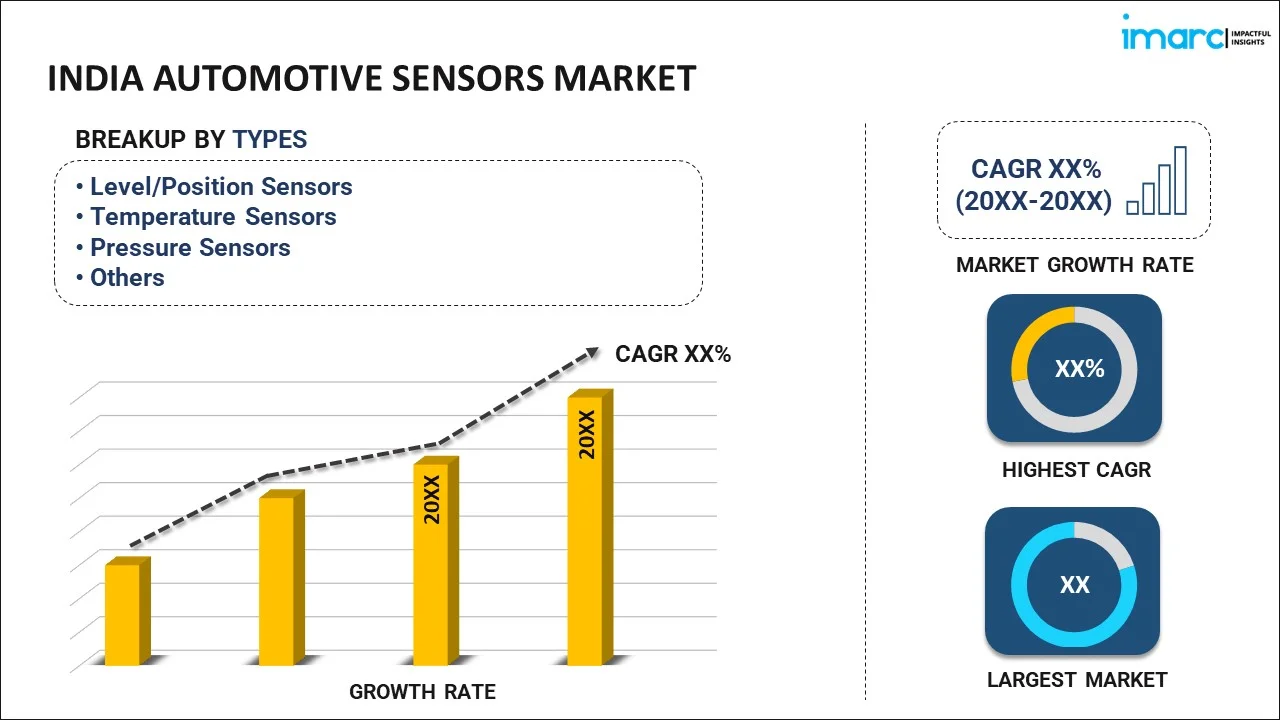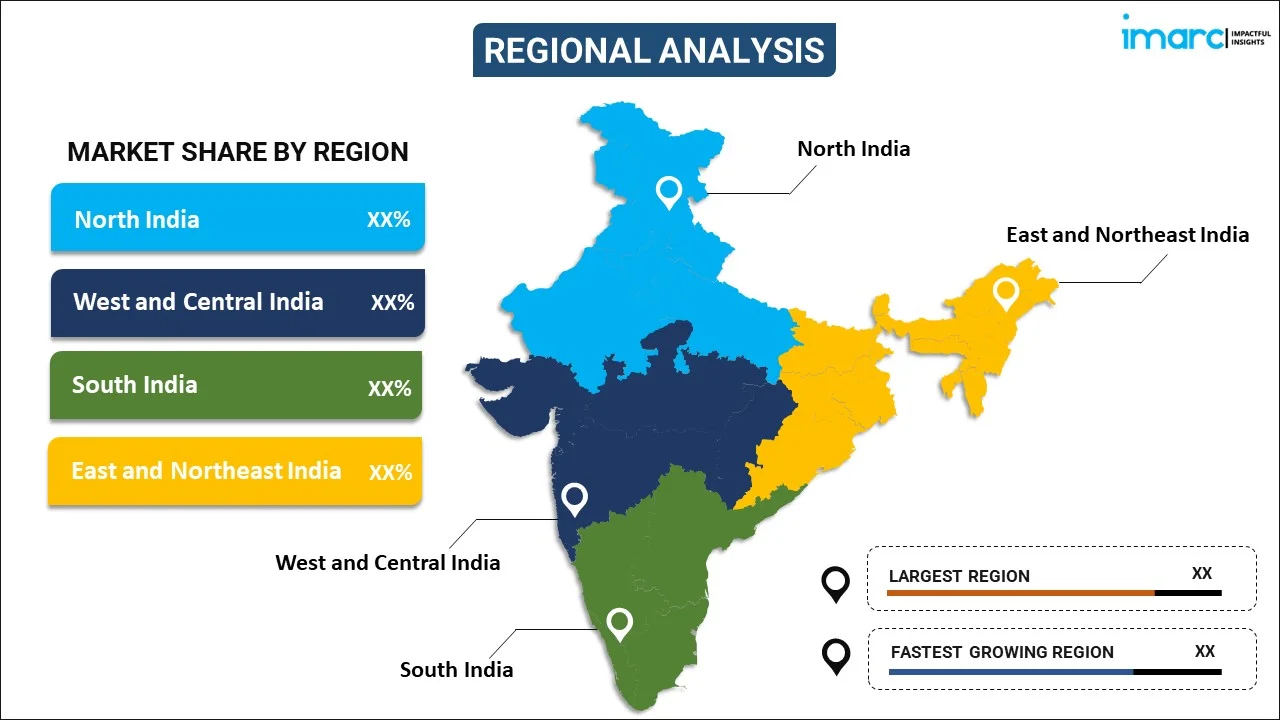
India Automotive Sensors Market Report by Type (Level/Position Sensors, Temperature Sensors, Pressure Sensors, Speed Sensors, Gas Sensors, Magnetic Sensors, and Others), Vehicle Type (Passenger Cars, Commercial Vehicles), Application (Powertrain, Chassis, Vehicle Body Electronics, Safety and Security, Telematics, and Others), Sales Channel (Original Equipment Manufacturer (OEM), Aftermarket), and Region 2024-2032
Market Overview:
India automotive sensors market size reached US$ 1.8 Billion in 2023. Looking forward, IMARC Group expects the market to reach US$ 6.3 Billion by 2032, exhibiting a growth rate (CAGR) of 14.40% during 2024-2032. The rising focus of key players on ensuring the optimal performance, efficiency, and emission control of vehicles while preventing potential damage and enhancing overall safety and reliability is primarily driving the market growth.
|
Report Attribute
|
Key Statistics
|
|---|---|
|
Base Year
|
2023
|
|
Forecast Years
|
2024-2032
|
|
Historical Years
|
2018-2023
|
|
Market Size in 2023
|
US$ 1.8 Billion |
|
Market Forecast in 2032
|
US$ 6.3 Billion |
| Market Growth Rate 2024-2032 | 14.40% |
Automotive sensors are smart devices designed to process information related to temperature, oil pressure, emissions, and coolant levels in vehicles. They encompass various types, including temperature, gas, speed, pressure, and magnetic sensors, and possess the capability to be computer-controlled. These devices perform calculations, such as determining air density in the engine, and play a critical role in monitoring essential parameters like the rotating speed of the crankshaft for fuel injection and engine timing control. Automotive sensors contribute significantly to the management of fuel injection and engine timing by overseeing the crankshaft's rotation speed. Additionally, they play a crucial role in analyzing the composition of exhaust gases, specifically the proportion of oxygen, to inform fuel metering strategies and emission controls. This monitoring ensures the efficient combustion of fuel, preventing potential damage to critical components like rings, head gaskets, and rod bearings in vehicles. Furthermore, these sensors serve diverse functions, including regulating the early fuel evaporation (EFE) system, adjusting spark advance, managing canister purge, and controlling the flow of exhaust gas recirculation (EGR).
India Automotive Sensors Market Trends:
The India automotive sensors market has witnessed substantial growth, reflecting the increasing integration of advanced sensor technologies in the country's automotive sector. In addition to their role in managing fuel injection and engine timing, automotive sensors in India contribute significantly to emission control. Additionally, the market is marked by continuous innovation, as sensors are increasingly employed to regulate various functions within vehicles. Moreover, this includes controlling the early fuel evaporation (EFE) system, adjusting spark advance, managing canister purge, and controlling the flow of exhaust gas recirculation (EGR). Besides this, the widespread adoption of automotive sensors aligns with the automotive industry's focus on safety, efficiency, and compliance with emission standards. Furthermore, as the automotive sector in India continues to evolve, driven by technological advancements and regulatory requirements, the demand for advanced automotive sensors is expected to rise. Apart from this, the integration of these sensors will play a crucial role in shaping the future of Indian vehicles, enhancing their performance, efficiency, and environmental sustainability, which is anticipated to fuel the market growth over the forecasted period.
India Automotive Sensors Market Segmentation:
IMARC Group provides an analysis of the key trends in each segment of the market, along with forecasts at the country level for 2024-2032. Our report has categorized the market based on type, vehicle type, application, and sales channel.
Type Insights:

- Level/Position Sensors
- Temperature Sensors
- Pressure Sensors
- Speed Sensors
- Gas Sensors
- Magnetic Sensors
- Others
The report has provided a detailed breakup and analysis of the market based on the type. This includes level/position sensors, temperature sensors, pressure sensors, speed sensors, gas sensors, magnetic sensors, and others.
Vehicle Type Insights:
- Passenger Cars
- Commercial Vehicles
A detailed breakup and analysis of the market based on the vehicle type have also been provided in the report. This includes passenger cars and commercial vehicles.
Application Insights:
- Powertrain
- Chassis
- Vehicle Body Electronics
- Safety and Security
- Telematics
- Others
The report has provided a detailed breakup and analysis of the market based on the application. This includes powertrain, chassis, vehicle body electronics, safety and security, telematics, and others.
Sales Channel Insights:
- Original Equipment Manufacturer (OEM)
- Aftermarket
A detailed breakup and analysis of the market based on the sales channel have also been provided in the report. This includes original equipment manufacturer (OEM) and aftermarket.
Regional Insights:

- North India
- West and Central India
- South India
- East and Northeast India
The report has also provided a comprehensive analysis of all the major regional markets, which include North India, West and Central India, South India, and East and Northeast India.
Competitive Landscape:
The market research report has also provided a comprehensive analysis of the competitive landscape. Competitive analysis such as market structure, key player positioning, top winning strategies, competitive dashboard, and company evaluation quadrant has been covered in the report. Also, detailed profiles of all major companies have been provided.
India Automotive Sensors Market Report Coverage:
| Report Features | Details |
|---|---|
| Base Year of the Analysis | 2023 |
| Historical Period | 2018-2023 |
| Forecast Period | 2024-2032 |
| Units | US$ Billion |
| Scope of the Report | Exploration of Historical and Forecast Trends, Industry Catalysts and Challenges, Segment-Wise Historical and Predictive Market Assessment:
|
| Types Covered | Level/Position Sensors, Temperature Sensors, Pressure Sensors, Speed Sensors, Gas Sensors, Magnetic Sensors, Others |
| Vehicle Types Covered | Passenger Cars, Commercial Vehicles |
| Applications Covered | Powertrain, Chassis, Vehicle Body Electronics, Safety and Security, Telematics, Others |
| Sales Channels Covered | Original Equipment Manufacturer (OEM), Aftermarket |
| Regions Covered | North India, West and Central India, South India, East and Northeast India |
| Customization Scope | 10% Free Customization |
| Report Price and Purchase Option | Single User License: US$ 2699 Five User License: US$ 3699 Corporate License: US$ 4699 |
| Post-Sale Analyst Support | 10-12 Weeks |
| Delivery Format | PDF and Excel through Email (We can also provide the editable version of the report in PPT/Word format on special request) |
Key Questions Answered in This Report:
- How has the India automotive sensors market performed so far and how will it perform in the coming years?
- What has been the impact of COVID-19 on the India automotive sensors market?
- What is the breakup of the India automotive sensors market on the basis of type?
- What is the breakup of the India automotive sensors market on the basis of vehicle type?
- What is the breakup of the India automotive sensors market on the basis of application?
- What is the breakup of the India automotive sensors market on the basis of sales channel?
- What are the various stages in the value chain of the India automotive sensors market?
- What are the key driving factors and challenges in the India automotive sensors?
- What is the structure of the India automotive sensors market and who are the key players?
- What is the degree of competition in the India automotive sensors market?
Key Benefits for Stakeholders:
- IMARC’s industry report offers a comprehensive quantitative analysis of various market segments, historical and current market trends, market forecasts, and dynamics of the India automotive sensors market from 2018-2032.
- The research report provides the latest information on the market drivers, challenges, and opportunities in the India automotive sensors market.
- Porter's five forces analysis assist stakeholders in assessing the impact of new entrants, competitive rivalry, supplier power, buyer power, and the threat of substitution. It helps stakeholders to analyze the level of competition within the India automotive sensors industry and its attractiveness.
- Competitive landscape allows stakeholders to understand their competitive environment and provides an insight into the current positions of key players in the market.
Need more help?
- Speak to our experienced analysts for insights on the current market scenarios.
- Include additional segments and countries to customize the report as per your requirement.
- Gain an unparalleled competitive advantage in your domain by understanding how to utilize the report and positively impacting your operations and revenue.
- For further assistance, please connect with our analysts.
 Inquire Before Buying
Inquire Before Buying
 Speak to an Analyst
Speak to an Analyst
 Request Brochure
Request Brochure
 Request Customization
Request Customization




.webp)




.webp)












